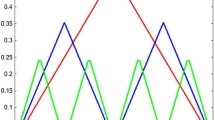Abstract
The theory of GBVPs provide the basis to the approximate methods used to compute global gravity models. A standard approximation procedure is least squares, which implicitly assumes that data, e.g. gravity disturbance and gravity anomaly, are given functions in L 2(S). We know that solutions in these cases exist, but uniqueness (and coerciveness which implies stability of the numerical solutions) is the real problem. Conditions of uniqueness for the linearized fixed boundary and Molodensky problems are studied in detail. They depend on the geometry of the boundary; however, the case of linearized fixed boundary BVP puts practically no constraint on the surface S, while the linearized Molodensky BVP requires the previous knowledge of very low harmonics, for instance up to degree 25, if we want the telluroid to be free to have inclinations up to 60°.
Similar content being viewed by others
References
Cimmino G (1955) Spazi hilbertiani di funzioni armoniche e questioni connesse. Equazioni lineari alle derivate parziali. Trieste 1954, UMI Roma
Heiskenen WA and Moritz H (1967). Physical geodesy. WH Freemann & Co, San Francisco
Holota P (1996) Variational methods for quasigeoid determination. In: Techniques for local geoid determination. In: Proceedings of session G7, EGS XXI general assembly, The Hague, The Netherlands, 6–10 May 1996. Reports of the Finnish geodetic Institute no. 96:2, Masala, 1996, pp 9–21
Holota P (1997). Coerciveness of the linear gravimetric boundary value problem and a geometric interpretation. J Geode 71: 640–651
Hormander L (1976). The boundary problems of physical geodesy. Arch Rat Mec An 62: 1–52
Pavlis NK (1997) Development and applications of geopotential models. Lecture notes of the International Geoid Service, International school for the determination and use of the Geoid. http://www.iges.polimi.it
Rozanov Y and Sansó F (2003). The analysis of the Neumann and oblique derivative problem. In: Weaktheory. Grafarend, WE, Krumm, FW and Schwarze, VS (eds) Geodesy: the challenge of the 3rd millennium, pp. Springer, Berlin
Sacerdote F and Sansó F (1986). The scalar boundary value problem of physical geodesy. Manusc Geod 11: 15–28
Sacerdote F, Sansó F (in print). On the universal solvability of classical value problem of potential theory. In: Proccedings of the VI Hotine Marussi symposium, Wuhan 2006, IAG symposia series, Springer, Heidelberg
Sansó F and Venuti G (2005). Topological vector spaces of harmonic functions and the trace operator. J Geod 79: 203–221
Svensson SL (1983). Pseudodifferential operators, a new approach to the boundary value problem of physical geodesy. Manusc Geod 8: 1–40
Yosida K (1978). Functional analysis. Springer, Berlin
Author information
Authors and Affiliations
Corresponding author
Rights and permissions
About this article
Cite this article
Sansò, F., Venuti, G. On the explicit determination of stability constants for linearized geodetic boundary value problems. J Geod 82, 909–916 (2008). https://doi.org/10.1007/s00190-008-0221-1
Received:
Accepted:
Published:
Issue Date:
DOI: https://doi.org/10.1007/s00190-008-0221-1




